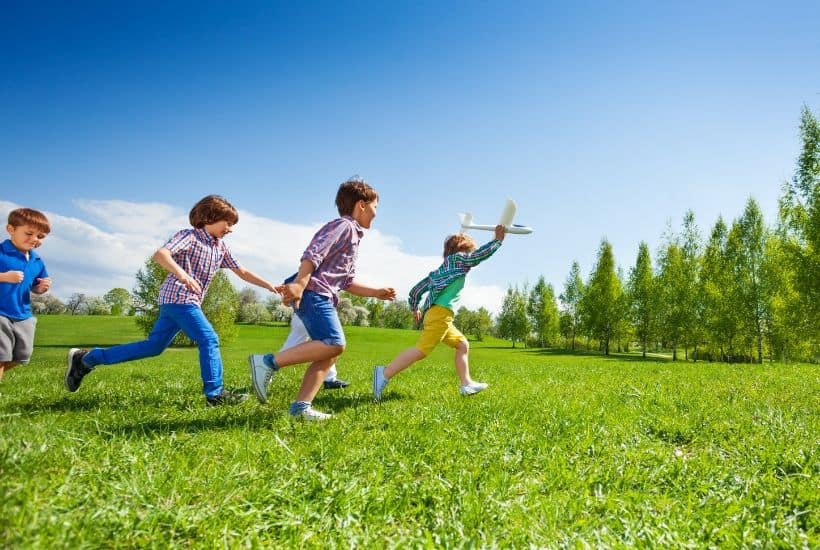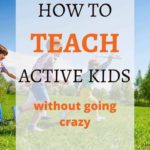How to Give Active Kids a Classical Education
This post may contain affiliate links. For more information, please read my disclosure policy.
Do you believe that classical education is only an appropriate homeschool method for quiet, studious children?
That you can’t teach active kids and give them a classical education? As the mom of 6 active kids let me tell you that nothing could be further from the truth.
You can give your active kids a classical education at home!
Learning is the atmosphere in which you educate
One of the principles of classical education is the principle of embodied learning, which means the atmosphere in which you educate your children.
After all, learning isn’t just the memorization you do. And it isn’t just the Latin chants or sitting down to read for hours. Education happens in an atmosphere. So does the atmosphere you homeschool support education?
This means for active kids, you don’t insist they sit down and read all day. Then fuss at them for wiggling at the table.
Instead, take a look at the atmosphere of your home. Is it set up for learning? Do you have science kits and art supplies available? Do you have interesting books and a cozy reading nook?
Did you bring a trampoline into your homeschool room so your daughter can jump while reciting math facts?
See the first trick to giving a classical education to active boys and girls is to set your home up for success.
Work with your child’s energy instead of against it.
Alternate Quiet Activities with Active Ones
After raising several active kids, I can assure you that children can sit down quietly for a time. But they don’t sit down for very long!
The trick I’ve found that works best for active kids is to alternate quiet activities with active activities.
This means you may sit down for a few minutes to work on phonics, curled up in a chair. But instead of sitting down inside to run through your memory work, head outside. Throw a ball while you recite poems. Throw hoops. Recite a poem and have your son act it out.
And you can do the same inside. Chant your memory work while marching around the house. Have your son jump on the trampoline chanting Latin declensions. Have your daughter march around the house.
Then sit back down to complete a math worksheet.
Alternating quiet and active activities will keep your children engaged with their schoolwork. While giving them a chance to bounce.
Outdoor Play Before Lessons
Another easy trick is to send your kids outside to play before you begin the day’s schoolwork. Kids, both boys and girls, wake up energetic. They’re refreshed and they have energy to burn.
So send your boys outside to run, to play, and to yell. This will give you a chance to tidy up the house, start a load of laundry, or simply sit down and enjoy a cup of coffee.
After the kids have run around for a time, call them in for morning time.
Everyone will be happier after a good run around the backyard.
Small Toys Help with Lessons
I cannot tell you how many times my children have brought toys to the kitchen table for homeschooling.
One son lined his small plastic dinosaurs around his math worksheet and consult them over every single math problem. It was cute. It was adorable. And math took forever to complete!
But he was happy and learning while he and his dinosaurs studied math.
I’ve seen my children bring stuffed animals, dolls, and even cars to the table.
The amazing thing is that the toys actually helped my kids settle down and do the work. It did take a few minutes longer, but the kids enjoyed discussing their schoolwork with their favorite animals or even cars as they completed the assignments.
So don’t fuss if your active kids want to bring their toys to the table.
Teach active Kids with manipulatives
Along the same line as small toys, manipulatives are a boon to the homeschool. Often active boys and girls resist sitting down and working through a worksheet. But they’re more than happy to work through their math problems with counting teddy bears or pattern blocks.
Active kids love to move. They love to play. And they love to explore.
Manipulatives help kids do just that.
So invest in manipulatives. Invest in word tiles. And invest in counting teddy bears and pattern blocks.
Don’t forget to pick up a set of magnetic letters for the fridge. They’re perfect for spelling and phonics practice for young kids.
As your kids get older, be sure to grab a set of magnetic words to add to the fridge. You can use them for grammar practice. Or just to leave silly messages to each other.
Teach Active Kids Using Games
Another fun trick is to teach active kids using games. Games teach kids so many skills! You can find games that teach math like Monopoly. You can find games that teach language arts skills and the parts of speech.
You can create games to teach phonics, math, and Latin.
Do a spelling bee with your kids. Or try holding a memory work bee and see which child remembers the most.
Encourage your kids to get up and move around as they play games.
And remember that games don’t need to be elaborate to be fun. Sometimes it’s enough to sit down with a bowl of M&M’s and test math facts. Earning an M&M for every correct math fact is its own reward.
Teach Active Kids science
Science should be more than just textbooks for all children and especially active ones. After all, science includes nature study and experimentation!
You have several ways of introducing science to your kids. The first is to focus on nature study for the elementary years. The kids learn a huge amount of science as they study astronomy, animals, rocks, clouds, and the weather.
And nature is best studied outside! Head out for a nature hike. Stop and study the flowers. Listen to the woodpeckers. Admire the hummingbird hoving next to a flower.
Take a camera and take pictures of the birds and plants you see. Or take paper and colored pencils to stop and draw the nature around you.
Along the same line, if you prefer a more traditional approach, is to include plenty of science experiments in your homeschool. Teach active kids the difference between gas, liquids, and solids using water.
Purchase science kits and let the kids spend rainy afternoons exploring scents, tastes, and mechanics.
Make science in the early years hands-on and add explanations as needed. Your kids will love the active approach to learning.
History and reading aloud
History is a story. And even active kids love listening to stories! Use an engaging history program like Story of the World. Introduce history to your children as a story.
A story of people, places, and events that continues to this day.
If you’re wondering how to keep your kids sitting still to listen, you’ve come to the right place.
My kids love to draw and color while they listen to history and a read-aloud. So I keep a basket of chalk pastels or crayons on the table for the kids to use and print coloring pages when we have them.
The kids also enjoy listening to books while they eat lunch or enjoy a cup of tea.
I’ve found any quiet activity that keeps their hands busy helps to keep my active children quiet and listening.
And keep in mind there are many, many hands-on history projects you can use to enliven your studies. For instance, you can try eating foods that the people you’re studying would have eaten.
Try making costumes in the same style of dress. Re-enact battles, plays, and other scenarios to bring history to life.
Your kids don’t need to passively sit and listen. They can also make armor out of cardboard or try their hand at creating a Greek vase.
Keep history active.
The secret to giving active kids a classical education is to keep them moving and engaged. Add history projects and science experiments to your studies. Head out on nature walks. And alternate between active studies and quiet studies.
Soon you’ll find it’s easy to teach active kids at home.
Recommended Reading:
Books:
Links:
- 7 Amazing, Gross, and Fun Science Kits for Kids
- 21 Wonderful and Amazing History Books for Kids
- How to Start Exploring Nature with Children
Like this post? Pin it!










All good tips, only thing is you keep referring to boys and your son, some girls are very active too and all the tips and things apply to them just as much. I don’t like the assumption that boys are active and girls are quiet. Quite the opposite in my house and I have both. Wouldn’t it be better to just use the term children or child? Otherwise great tips that I will be implementing with my girls.😀
You’re right, Janine. Some girls are very active too! 🙂